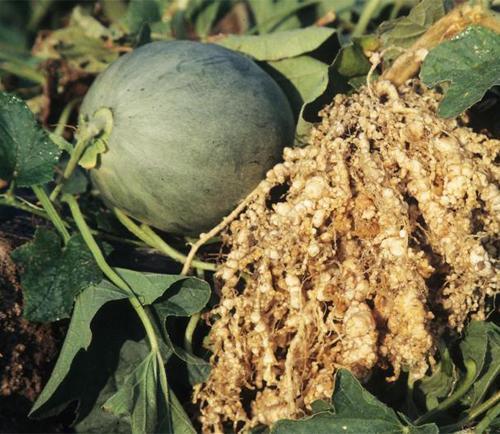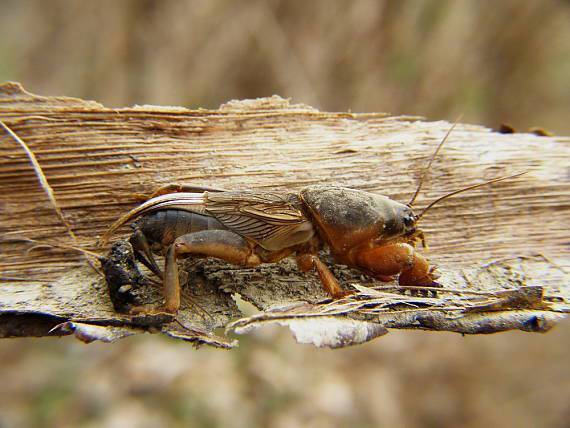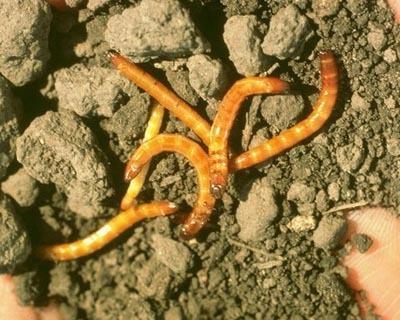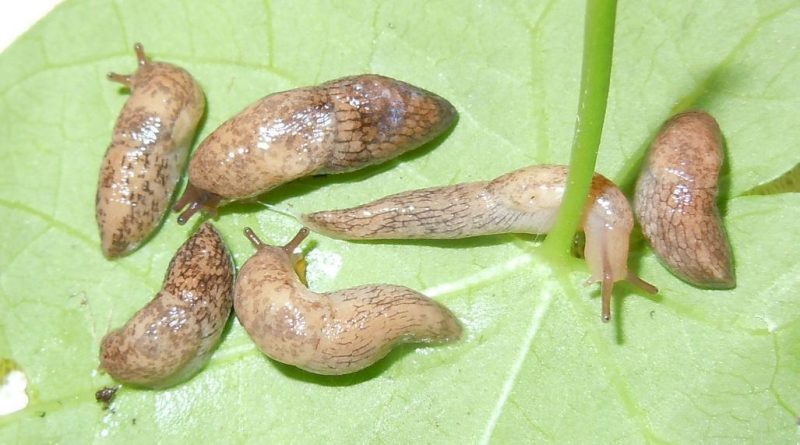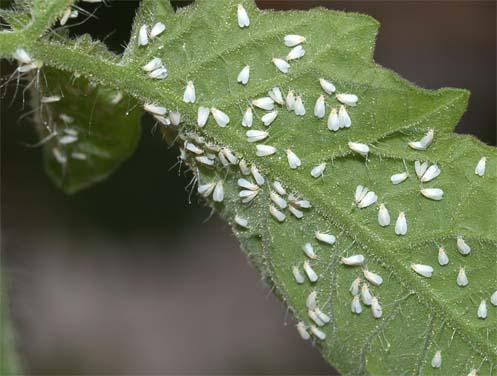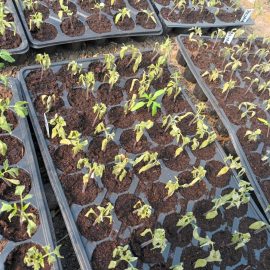Pest control in protected areas
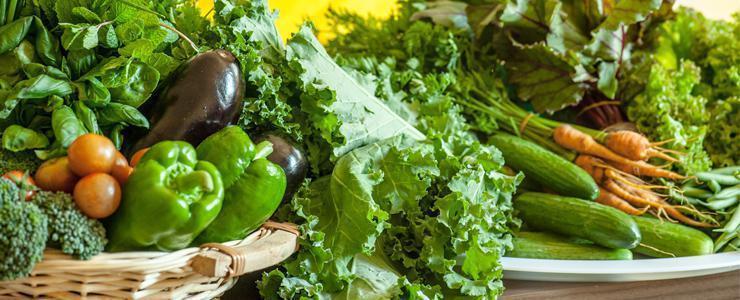
In the cold season, most vegetable growers in protected areas (greenhouses, polyhouses) have already prepared the first cycle of production, sowed the seeds, and prepared for planting, which is done in early spring (from March to mid-April).
During this period the main concern of vegetable growers must be to eliminate potential sources of massive pest infestation of protected areas. These are most often crop debris, infested soil, or organic fertilizer.
The main pests that can create problems for future crops are:
Meloidogyne incognita (The southern root-knot nematode)
It is a very widespread species, but only in greenhouse or polyhouses conditions. They are represented as small worms 1.2-2 mm long. The male is cylindrical and the female has a pyriform appearance and a long neck that shortens with age. Root-knot nematodes overwinter in the field, in the female’s body, in the egg stage, and greenhouses or polyhouses, overwinter as females or second instar larvae.
The pest requires high temperatures for development or an increased number of generations. Being thermophilic, it can have 8-10 generations/year, at an optimum temperature between 20-30 ºC.
Root-knot nematode causes great damage to cucumbers, tomatoes, and aubergines, but also to lettuce, peppers and carrots. Attacked plants can be recognized by the fact that they have root blisters of various sizes, up to 5 cm in diameter. The shape and size of the galls vary depending on the host plant, the nematode population size, and environmental conditions (temperature and soil moisture).
Strongly attacked plants wilt, but in a weak attack or early attack, the infested plant has no special characteristic compared to a healthy one. Often, the less resistant tissue of the galls rots and the plant may be infected with pathogenic or saprophytic organisms from the soil. In tomatoes and other crops (cucumbers), nematode attack is associated with pathogens of the genera Fusarium, Verticilium, Alternaria, and Pythium, which can lead to total crop decline.
Advice for nematode control
It is recommended to procure the plant material from reliable sources and control it thoroughly by specific methods for nematode detection.
Locally, the species spread may be facilitated by water from rainfall or irrigation. Do not transplant plants with roots or soil from infested greenhouses to other greenhouses. Applying manure that is not well decomposed can spread soil pests and therefore special precautions should be taken in seedling polyhouses.
Controlling the seedlings, disinfecting tools, and collecting and destroying plant debris after harvesting help to control this pest. Growing resistant varieties and treating them with nematocidal products is the most effective way to control nematodes.
Gryllotalpa gryllotalpa (The European mole cricket)
It overwinters as an adult or third-age larva in soil 30-40 cm deep. Tillage in spring with disc harrow, mechanical and manual pruning, and autumn plowing before the pest retreats for overwintering destroys large numbers of eggs, larvae, and adults.
These works, even if carried out during the resting period in protected spaces, help to reduce pest populations.
In organic farming, trap pits measuring 50x50x50 cm, dug in autumn and filled with manure, attract a large number of mole crickets. This manure, which is spread in winter or burned in early spring, can be a pest control solution.
Currently, the best results are achieved by soil treatments with granular products approved for soil pest control or with toxic baits.
Recommended products
-
You can find products on a different store
Change Store -
You can find products on a different store
Change Store -
You can find products on a different store
Change Store -
You can find products on a different store
Change Store -
You can find products on a different store
Change Store -
You can find products on a different store
Change Store -
You can find products on a different store
Change Store -
You can find products on a different store
Change Store -
You can find products on a different store
Change Store -
You can find products on a different store
Change Store -
You can find products on a different store
Change Store -
You can find products on a different store
Change Store -
You can find products on a different store
Change Store -
You can find products on a different store
Change Store -
You can find products on a different store
Change Store -
You can find products on a different store
Change Store -
You can find products on a different store
Change Store -
You can find products on a different store
Change Store -
You can find products on a different store
Change Store -
You can find products on a different store
Change Store -
You can find products on a different store
Change Store -
You can find products on a different store
Change Store -
You can find products on a different store
Change Store -
You can find products on a different store
Change Store
Agriotes sp. (Wireworms)
They overwinter in the soil as larvae of various ages, but also as adults. Adult insects overwinter in burrows made of soil particles. After sowing, the larvae feed on the seeds, which they gnaw off the embryo, leaving only the integument intact.
The attacked crop shows large gaps during sprouting. After emergence, the attack continues, the plants being gnawed in the crown or root zone. The grub larvae attack is mostly seen in cold, wet springs, in the soils where sowing was carried out at a greater depth and the plants sprouted late. The most important preventive measures are prophylactic measures, which reduce pest populations. Among these measures, it is recommended to plow immediately after harvesting the crop.
Recommended products
-
You can find products on a different store
Change Store -
You can find products on a different store
Change Store -
You can find products on a different store
Change Store -
You can find products on a different store
Change Store -
You can find products on a different store
Change Store -
You can find products on a different store
Change Store -
You can find products on a different store
Change Store -
You can find products on a different store
Change Store -
You can find products on a different store
Change Store -
You can find products on a different store
Change Store -
You can find products on a different store
Change Store -
You can find products on a different store
Change Store -
You can find products on a different store
Change Store -
You can find products on a different store
Change Store -
You can find products on a different store
Change Store -
You can find products on a different store
Change Store -
You can find products on a different store
Change Store -
You can find products on a different store
Change Store -
You can find products on a different store
Change Store -
You can find products on a different store
Change Store -
You can find products on a different store
Change Store -
You can find products on a different store
Change Store -
You can find products on a different store
Change Store -
You can find products on a different store
Change Store
Deroceras agreste (Grey field slug)
It overwinters as an egg in the soil at a depth of 20-30 cm. They are commonly found in sheltered areas and can cause significant damage to root crops in years with mild winters followed by wet, cool springs.
As plants appear, larvae and adults gnaw on emerging plants. Mobilising the soil with a rotating harrow at a depth of 14-16 cm destroys part of the slug population as well as their shelter.
Recommended products
-
You can find products on a different store
Change Store -
You can find products on a different store
Change Store -
You can find products on a different store
Change Store -
You can find products on a different store
Change Store -
You can find products on a different store
Change Store -
You can find products on a different store
Change Store -
You can find products on a different store
Change Store -
You can find products on a different store
Change Store -
You can find products on a different store
Change Store -
You can find products on a different store
Change Store -
You can find products on a different store
Change Store -
You can find products on a different store
Change Store -
You can find products on a different store
Change Store -
You can find products on a different store
Change Store -
You can find products on a different store
Change Store -
You can find products on a different store
Change Store -
You can find products on a different store
Change Store -
You can find products on a different store
Change Store -
You can find products on a different store
Change Store -
You can find products on a different store
Change Store -
You can find products on a different store
Change Store -
You can find products on a different store
Change Store -
You can find products on a different store
Change Store -
You can find products on a different store
Change Store
Trialeurodes vaporariorum (Greenhouse whitefly)
It overwinters as an adult in protected spaces. Pest populations are reduced by temperatures falling below 0ºC, a natural phenomenon in polyhouses or greenhouses that remain unheated during winter.
The main thing to keep in mind is horticultural hygiene. This means removing and burning plant debris and ensuring that seedlings and planting materials are safe, healthy, and from certified sources. Whitefly infestation is dangerous both for the damage the insect causes directly and for the damage it is indirectly responsible for.
The greenhouse whitefly is an important transmission vector for several plant viruses. Its droppings, which contain sweet substances, also favor the emergence of pathogenic fungi such as Alternaria or Fusarium.
Recommended products
-
You can find products on a different store
Change Store -
You can find products on a different store
Change Store -
You can find products on a different store
Change Store -
You can find products on a different store
Change Store -
You can find products on a different store
Change Store -
You can find products on a different store
Change Store -
You can find products on a different store
Change Store -
You can find products on a different store
Change Store -
You can find products on a different store
Change Store -
You can find products on a different store
Change Store -
You can find products on a different store
Change Store -
You can find products on a different store
Change Store -
You can find products on a different store
Change Store -
You can find products on a different store
Change Store -
You can find products on a different store
Change Store -
You can find products on a different store
Change Store -
You can find products on a different store
Change Store -
You can find products on a different store
Change Store -
You can find products on a different store
Change Store -
You can find products on a different store
Change Store -
You can find products on a different store
Change Store -
You can find products on a different store
Change Store -
You can find products on a different store
Change Store -
You can find products on a different store
Change Store
Pest control measures
The main pest control measures in the cold season in protected areas refer to:
- crop hygiene measures;
- agrotechnical measures to destroy the plant debris;
- autumn plowing (reduces populations of thrips, white and grey grubs);
- repeated tillage (causes larvae to appear on the surface and be exposed to weather and various predators);
- applying well-decomposed manure free of soil pests;
- controlling the seedlings that will be introduced into protected spaces;
- disinfecting tools.
The best results for pest control are achieved with soil treatments. These can be carried out using granular products approved for soil pest control.















































































































































































































































































































































































































































